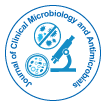
Journal of Clinical Microbiology and Antimicrobials
Open Access
+44-77-2385-9429

+44-77-2385-9429
Opinion Article - (2024)Volume 8, Issue 3
Adenovirus infections in organ transplant recipients pose a significant challenge due to the immunocompromised nature of these patients. Organ transplantation is a life-saving procedure for patients with end-stage organ failure; however, the immunosuppressive therapy required to prevent organ rejection also weakens the body’s immune defenses, making these patients more susceptible to infections, including those caused by viruses like adenoviruses. Adenoviruses can lead to severe infections in transplant recipients, potentially affecting multiple organ systems and contributing to increased morbidity and mortality rates. This study discusses the impact of adenovirus infections in organ transplant recipients, discussing the clinical manifestations, diagnostic challenges, treatment options and strategies for prevention.
Adenovirus infections in organ transplant
Adenoviruses are a group of DNA viruses that can cause a variety of diseases, ranging from mild respiratory symptoms to severe multi-organ infections. These infections are typically self-limiting in immunocompetent individuals, but in organ transplant recipients, the clinical outcomes can be much more severe. The risk of adenovirus infection is particularly high during the early post-transplant period when immunosuppressive medications are most potent. Adenovirus infections in transplant recipients can present with a wide range of symptoms depending on the organ system affected. The most common manifestations include:
Respiratory infections: Adenovirus is a known cause of respiratory illness, including pharyngitis, conjunctivitis, and pneumonia. In transplant recipients, respiratory symptoms may be more severe and difficult to differentiate from other infections, such as bacterial pneumonia or viral infections like influenza.
Gastrointestinal infections: Gastroenteritis caused by adenoviruses can lead to diarrhea, vomiting, and abdominal pain. In immunocompromised patients, this infection can become more prolonged and severe, leading to dehydration and other complications.
Hepatitis: Adenovirus infection can also affect the liver, causing hepatitis, which may present as jaundice, elevated liver enzymes and liver dysfunction. This is particularly concerning in liver transplant recipients.
Urological infections: In kidney transplant recipients, adenoviruses can cause hemorrhagic cystitis, a painful condition characterized by blood in the urine, bladder irritation and frequent urination.
Diagnosis of adenovirus infections
Early diagnosis of adenovirus infections in transplant recipients is important for initiating appropriate treatment and preventing severe outcomes. However, diagnosing adenovirus infections can be challenging due to the nonspecific nature of symptoms and the overlap with other infections, such as bacterial pneumonia or Cytomegalovirus (CMV) infections. Viral culture can be used to isolate adenovirus from clinical samples, but it is less commonly used due to its lower sensitivity and the longer time required for results. It is typically employed when PCR results are inconclusive. Enzyme Immunoassays (EIA) can be used to detect adenovirus antigens in respiratory or gastrointestinal samples. These tests offer quicker results than culture but may be less sensitive than PCR. In cases of suspected tissue involvement (e.g., hepatitis or pneumonia), immunohistochemistry can be used to detect adenovirus antigens in tissue biopsies, although this is more invasive and less commonly performed. The nonspecific nature of symptoms and the wide range of possible infections in transplant recipients make it difficult to diagnose adenovirus infections promptly. Additionally, the potential for coinfections with other viruses or bacteria complicates the diagnostic process. Furthermore, in some cases, patients may be asymptomatic or exhibit only mild symptoms, which can lead to delays in detection and treatment..
Treatment of adenovirus infections
While adenovirus infections in immunocompromised patients can be life-threatening, antiviral treatments are available to help manage the infection. However, the choice of therapy depends on the severity of the infection, the organ involved, and the patient’s overall condition. Cidofovir is an antiviral drug that is commonly used for the treatment of adenovirus infections in transplant recipients. It is effective against a wide range of adenovirus serotypes and can be administered intravenously. Cidofovir is often used for severe infections, particularly when the infection involves multiple organs. A novel antiviral drug, brincidofovir, is related to cidofovir but has a more favorable safety profile, including less nephrotoxicity. It is being investigated as a potential treatment for adenovirus infections in transplant patients. Other antiviral agents, such as interferonalpha, have been investigated for their potential use in adenovirus infections, but they are not routinely used due to limited efficacy and significant side effects. In addition to antiviral treatment, supportive care is essential in managing adenovirus infections in transplant recipients. In cases of gastrointestinal infections, maintaining hydration and electrolyte balance is important to prevent dehydration and further complications. For patients with adenovirus pneumonia, respiratory support, including oxygen therapy or mechanical ventilation, may be required. Preventing adenovirus infections in organ transplant recipients requires a combination of strategies. Screening both donors and recipients for adenovirus antibodies or viral DNA may help identify those at risk for infection. Regular monitoring of viral loads through PCR testing can help detect asymptomatic infections and guide antiviral treatment before the infection becomes severe. Strict infection control protocols, including isolation of infected patients and precautions to prevent the spread of adenovirus, are important in transplant units. Adenovirus infections represent a significant risk to organ transplant recipients, with the potential for severe and life-threatening outcomes. Early diagnosis, effective antiviral treatment and appropriate supportive care are essential in managing these infections. Preventive measures, including screening and viral load monitoring, can help reduce the incidence and severity of adenovirus infections in this vulnerable patient population. As research into antiviral therapies continues, the outlook for transplant recipients with adenovirus infections may improve, although challenges in diagnosis and treatment remain.
Citation: Chong J (2024). The Impact of Adenovirus Infections in Organ Transplant Recipients. J Clin Microbiol Antimicrob. 8: 205.
Received: 27-Aug-2024, Manuscript No. JCMA-24-35607; Editor assigned: 28-Aug-2024, Pre QC No. JCMA-24-35607 (PQ); Reviewed: 11-Sep-2024, QC No. JCMA-24-35607; Revised: 18-Sep-2024, Manuscript No. JCMA-24-35607 (R); Published: 27-Sep-2024 , DOI: 10.35248/ JCMA.24.8.205
Copyright: © 2024 Chong J. This is an open-access article distributed under the terms of the Creative Commons Attribution License, which permits unrestricted use, distribution, and reproduction in any medium, provided the original author and source are credited.